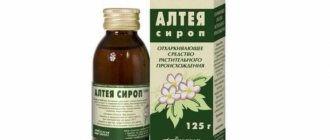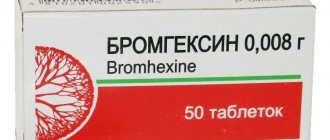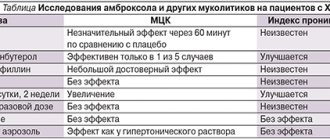Syrup 15 mg/5 ml
Use in children
Lazolvan® children's syrup can be used to treat cough with viscous sputum in children. It has a pleasant aroma of forest berries, so children usually do not resist taking the drug.
The instructions for the drug Lazolvan® syrup 15 mg/5 ml recommend the following dosages for children:
- At the age of up to 2 years: 2.5 ml 2 times a day.
- Children aged 2 to 6 years: 2.5 ml 3 times a day.
- Children from 6 to 12 years old: 5 ml 2-3 times a day.
Dosage for adults and children over 12 years of age: 10 ml 3 times a day.
You can take cough syrup regardless of meals.3
During lactation
The period of lactation and breastfeeding is a contraindication for the use of Lazolvan® syrup, as well as tablets, solution and other forms of this drug.3
One of the main reasons for this is the ability of ambroxol hydrochloride, the active ingredient in Lazolvan®, to pass into breast milk. However, no adverse events were observed in children who were breastfed by mothers taking medications with ambroxol. Despite this, it is not recommended to use Lazolvan® syrup for the treatment of mothers while breastfeeding.3
Use during pregnancy
Lazolvan® syrup is not used in the first trimester of pregnancy.3
The active ingredient of the drug, Ambroxol, can penetrate the placental barrier. Studies have not shown that it can affect the course of pregnancy, the fetus and its development, or labor. The experience of using Lazolvan® from the 28th week of pregnancy also did not show any negative effects on the fetus.
However, it is necessary to observe the usual precautions: taking the drug in the first trimester is not recommended, and in the second and third trimesters, treatment with Lazolvan® syrup according to indications is possible only as prescribed by a healthcare professional, under his supervision and if its use is justified by the benefits for the patient. mother, and the risk of exposure to the fetus is lower than the potential benefit. 3
For impaired renal function
If renal function is impaired, Lazolvan® syrup can be used only as prescribed by a healthcare professional. Self-medication in this case is unacceptable for the following reasons:
- Due to kidney failure, toxins can accumulate in the human body. “Adding” another xenobiotic, a foreign substance, can provoke a deterioration in the functionality of the urinary system.
- Against the background of renal failure, many processes change, for which they are directly or indirectly responsible: filtration in the glomerular system; distribution of drugs and their metabolites among organs and systems with the blood; removal of residual amounts of the substance and its derivatives.
- Renal failure is often accompanied by systemic changes in the functioning of the heart, blood vessels, and lymphatic system. It can lead to a decrease in clearance - that is, the rate of purification of the blood (plasma) from a drug or other biological substance.
A healthcare specialist, after assessing the tests and the risks of the impact of any form of Lazolvan® on the kidney function of a particular patient, will decide on the possibility of therapy, select the optimal and safe dose, and the number of doses per day.2, 3
For liver dysfunction
For liver diseases and liver failure, any form of Lazolvan® is prescribed with caution.3
The importance of the liver in the processes of absorption, distribution, neutralization and excretion of various substances is enormous. Diseases of this organ significantly impair its functionality, which also affects the processes of biotransformation of drugs.
In case of liver failure and other pathologies of the organ, the functioning of the enzyme system of the liver and gall bladder is disrupted. This can cause uneven absorption of active substances, changes in the processes of their absorption, which carries the risk of overdose or, conversely, insufficient dosage.1, 2
Only a health care professional can select a dose for a patient with renal failure based on test results, assessment of the dynamics of the patient’s condition and medical history.
Active substance
The therapeutic effect in Lazolvan® syrup is provided by ambroxol hydrochloride: 5 ml of syrup contains 15 mg of this substance. This is a drug from the group of mucolytic and expectorant drugs.3
It affects the production of surfactant - a substance that coats the inside of the walls of the alveoli and prevents them from collapsing.4
Ambroxol improves mucociliary clearance, production, liquefaction of mucus and its excretion. Thanks to this, the discharge of sputum is enhanced and facilitated, and the cough is relieved.3
Lazolvan children's cough syrup with sputum 15 mg/5ml 100ml
A country
France
The country of production may vary depending on the batch of goods. Please check with the operator for detailed information when confirming your order.
Active substance
Ambroxol
Compound
Active substance: ambroxol hydrochloride.
pharmachologic effect
Studies have shown that ambroxol, the active ingredient in the drug, increases secretion in the respiratory tract. It enhances the production of pulmonary surfactant and stimulates cipiary activity. These effects lead to increased mucus flow and transport (mucociliary clearance). Increasing mucociliary clearance improves sputum discharge and relieves cough. Pharmacokinetics: Ambroxol is characterized by rapid and almost complete absorption with a linear dose dependence in the therapeutic concentration range. Maximum plasma levels after oral administration are achieved within 1-2.5 hours. The distribution volume is 552 l. In the therapeutic concentration range, binding to plasma proteins is approximately 90%. The transition of ambroxol from the blood to tissues when administered orally occurs quickly. The highest concentrations of the active component of the drug are observed in the lungs. Approximately 30% of the administered oral dose undergoes first pass through the liver. Studies in human liver microsomes have shown that CYP3A4 is the predominant isoform responsible for the metabolism of ambroxol to dibromoantranilic acid. The remainder of ambroxol is metabolized in the liver, mainly by glucuronidation and by partial degradation to dibromoantranilic acid (approximately 10% of the administered dose), as well as a small number of additional metabolites. The terminal half-life of ambroxol is 10 hours. The total clearance is within 660 ml/min, renal clearance accounts for approximately 8% of the total clearance. No clinically significant effect of age and gender on the pharmacokinetics of ambroxol was found. therefore, there is no basis for selecting the dosage based on these characteristics.
Indications for use
Acute and chronic diseases of the respiratory tract with the release of viscous sputum: acute and chronic bronchitis, pneumonia, chronic obstructive pulmonary disease, bronchial asthma with difficulty in sputum discharge, bronchiectasis.
Mode of application
Orally. The drug is prescribed for adults and children over 12 years old: 10 ml 3 times a day; children from 6 to 12 years old: 5 ml 2-3 times a day; children from 2 to 6 years old: 2.5 ml 3 times a day ;children under 2 years of age: 2.5 ml 2 times a day. The drug can be used regardless of meals. If symptoms of the disease persist within 4-5 days from the start of treatment, it is recommended to consult a doctor.
Interaction
No clinically significant, undesirable interactions with other drugs have been reported. Increases the penetration of amoxicillin and cefuroxime into the bronchial secretions. erythromycin.
Side effect
Gastrointestinal disorders. Often – nausea; uncommon - heartburn, dyspepsia, vomiting, diarrhea, abdominal pain, dry mouth; rarely - dry throat. Immune system disorders, damage to the skin and subcutaneous tissues. Rarely - rash, urticaria; anaphylactic reactions (including anaphylactic shock), angioedema, itching, hypersensitivity. Disorders of the nervous system. Often - dysgeusia (impaired taste).
Contraindications
Hypersensitivity to ambroxop or other components of the drug, pregnancy (first trimester), lactation period.
Overdose
Specific symptoms of overdose in humans have not been described. There are reports of accidental overdose and/or medical error, as a result of which symptoms of known side effects of the drug Lazolvan were observed: nausea, dyspepsia, diarrhea, vomiting, abdominal pain. In this case, there may be a need for symptomatic therapy Treatment: artificial vomiting, gastric lavage in the first 1-2 hours after taking the drug; symptomatic therapy.
special instructions
The syrup contains 10.5 g of sorbitol based on the maximum recommended daily dose (30 ml). Patients with rare hereditary fructose intolerance should not take this drug. Use the drug with caution during pregnancy (II - III trimester), with renal and/or liver failure. Use during pregnancy and breastfeeding. Ambroxol penetrates the placental barrier. Preclinical studies have not revealed direct or indirect adverse effects on pregnancy, embryonic, fetal, postnatal development and childbirth. Extensive clinical experience with the use of ambroxol after 28 weeks of pregnancy has not found evidence of a negative effect of the drug on the fetus. However, normal precautions must be taken when using the medicine during pregnancy. It is especially not recommended to take the drug in the first trimester of pregnancy. Ambroxol can be excreted in human milk. Despite the fact that no undesirable effects were observed in breast-fed children, it is not recommended to use the drug during lactation. Preclinical studies of ambroxol have not revealed a negative effect on fertility. It should not be combined with antitussives that impede the removal of sputum. Included in the syrup sorbitol may have a mild laxative effect. In patients with severe skin lesions - Stevens-Johnson syndrome or toxic epidermal necrolysis - fever, body pain, rhinitis, cough and sore throat may appear in the early phase. During symptomatic treatment, it is possible to erroneously prescribe mucolytic agents such as ambroxol hydrochloride. There are isolated reports of the detection of Stevens-Johnson syndrome and toxic epidermal necrolysis. coinciding with the prescription of the drug: however, there is no cause-and-effect relationship with taking the drug. If the above syndromes develop, it is recommended to stop treatment and immediately seek medical help. If renal function is impaired, the drug should be used only on the recommendation of a doctor. Effect of the drug on the ability to drive vehicles and machinery. There have been no cases of the drug influencing the ability to drive vehicles and machinery. Studies on the effect of the drug on the ability to drive vehicles and engage in other potentially hazardous activities that require increased concentration and speed of psychomotor reactions have not been conducted.
Lazolvan solution
Release form
Solution for oral administration and inhalation. Transparent, colorless or slightly brownish.
Compound
Active ingredient : ambroxol hydrochloride (7.5 mg/1 ml).
Excipients : citric acid monohydrate; sodium hydrogen phosphate dihydrate; sodium chloride; benzalkonium chloride; purified water.
Pharmacological group
Secretolytics and stimulants of motor function of the respiratory tract.
Action
Mucolytic agent with expectorant action. Ambroxol increases the secretion of the glands of the respiratory tract, stimulates the activity of the villi of the respiratory tract, and enhances the formation of surfactant in the lungs. Ambroxol is a metabolite of bromhexine.
Ambroxol: description of the substance
Indications
Diseases of the respiratory tract with the formation of viscous sputum:
- acute and chronic bronchitis;
- pneumonia;
- COPD;
- bronchial asthma with difficulty in sputum discharge;
- bronchiectasis.
Contraindications and restrictions
- Hypersensitivity to ambroxol or other components of the drug;
- pregnancy (first trimester);
- lactation period.
Carefully:
- II–III trimester of pregnancy;
- renal and/or liver failure.
Application and dosage
Inside, inhalation.
Inside
Regardless of food intake (1 ml = 25 drops).
- Adults - 4 ml (= 100 drops) 3 times a day;
- children over 6 years old - 2 ml (= 50 drops) 2-3 times a day;
- children from 2 to 6 years old - 1 ml (= 25 drops) 3 times a day;
- children under 2 years old - 1 ml (= 25 drops) 2 times a day.
Drops can be diluted in water, tea, juice or milk.
Inhalation
- Adults and children over 6 years of age: 1–2 inhalations of 2–3 ml of solution per day;
- children under 6 years of age: 1–2 inhalations of 2 ml of solution per day.
Lazolvan solution for inhalation can be used using any modern equipment for inhalation (except steam inhalers). To achieve maximum hydration during inhalation, the drug is mixed with 0.9% sodium chloride solution in a 1:1 ratio. Since during inhalation therapy a deep breath can provoke a cough, inhalations should be carried out in normal breathing mode. Before inhalation, it is usually recommended to warm the inhalation solution to body temperature. Patients with bronchial asthma are recommended to carry out inhalation after taking bronchodilators to avoid nonspecific irritation of the respiratory tract and their spasm.
If symptoms of the disease persist within 4-5 days from the start of taking the drug, it is recommended to consult a doctor.
special instructions
The solution contains the preservative benzalkonium chloride, which, when inhaled, may cause bronchospasm in sensitive patients with increased respiratory tract reactivity.
Patients on a hyposodium diet should take into account that Lazolvan solution for oral administration and inhalation contains 42.8 mg of sodium in the recommended daily dose (12 ml) for adults and children over 12 years of age.
Production
- JSC Sanofi Russia;
- Instituto de Angeli S.r.L. (Italy).
Package
100 ml dark amber glass bottle with a beaker and a polypropylene screw cap with tamper evident in a cardboard box.
Recipe
Available without a prescription.





